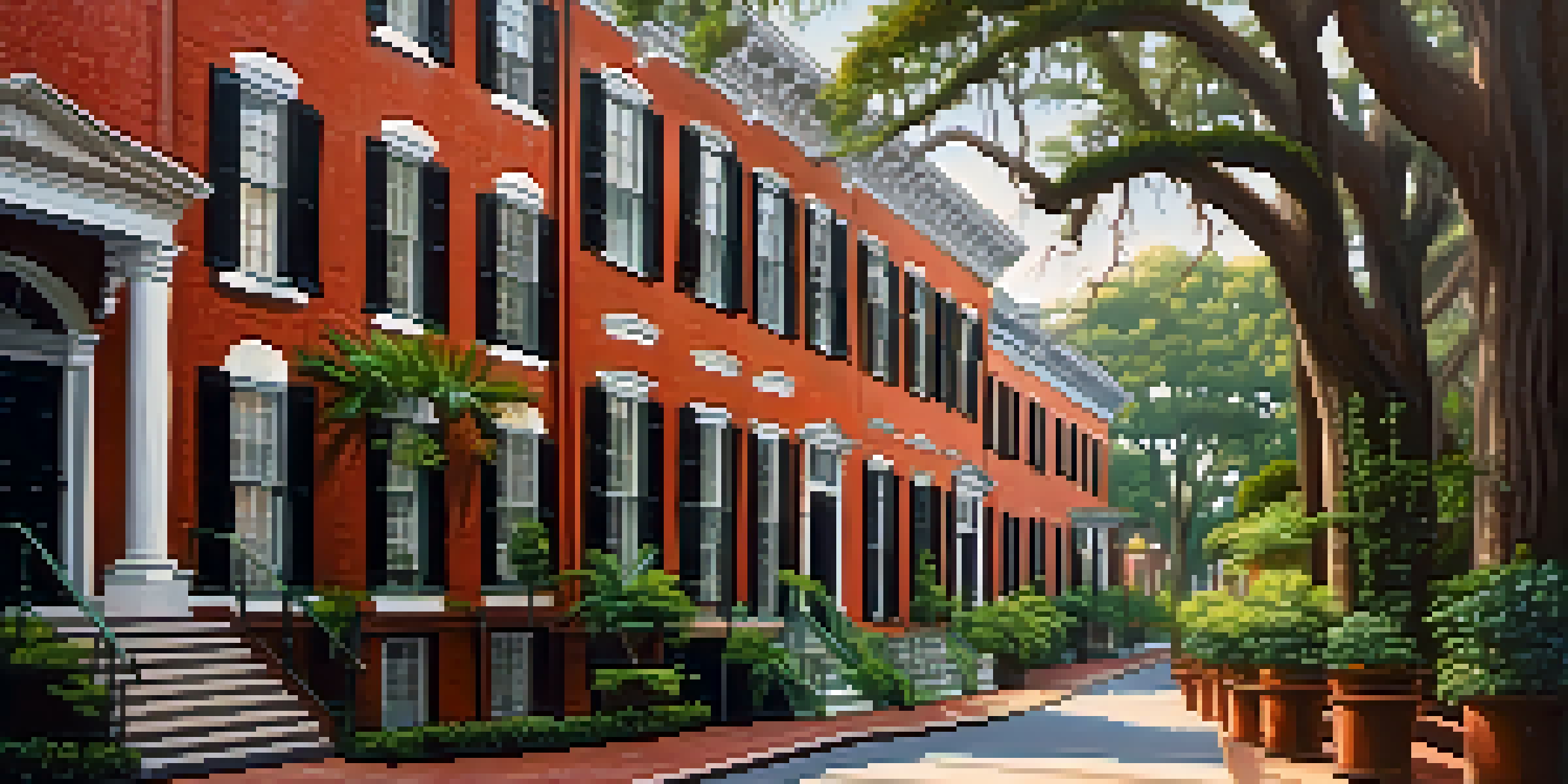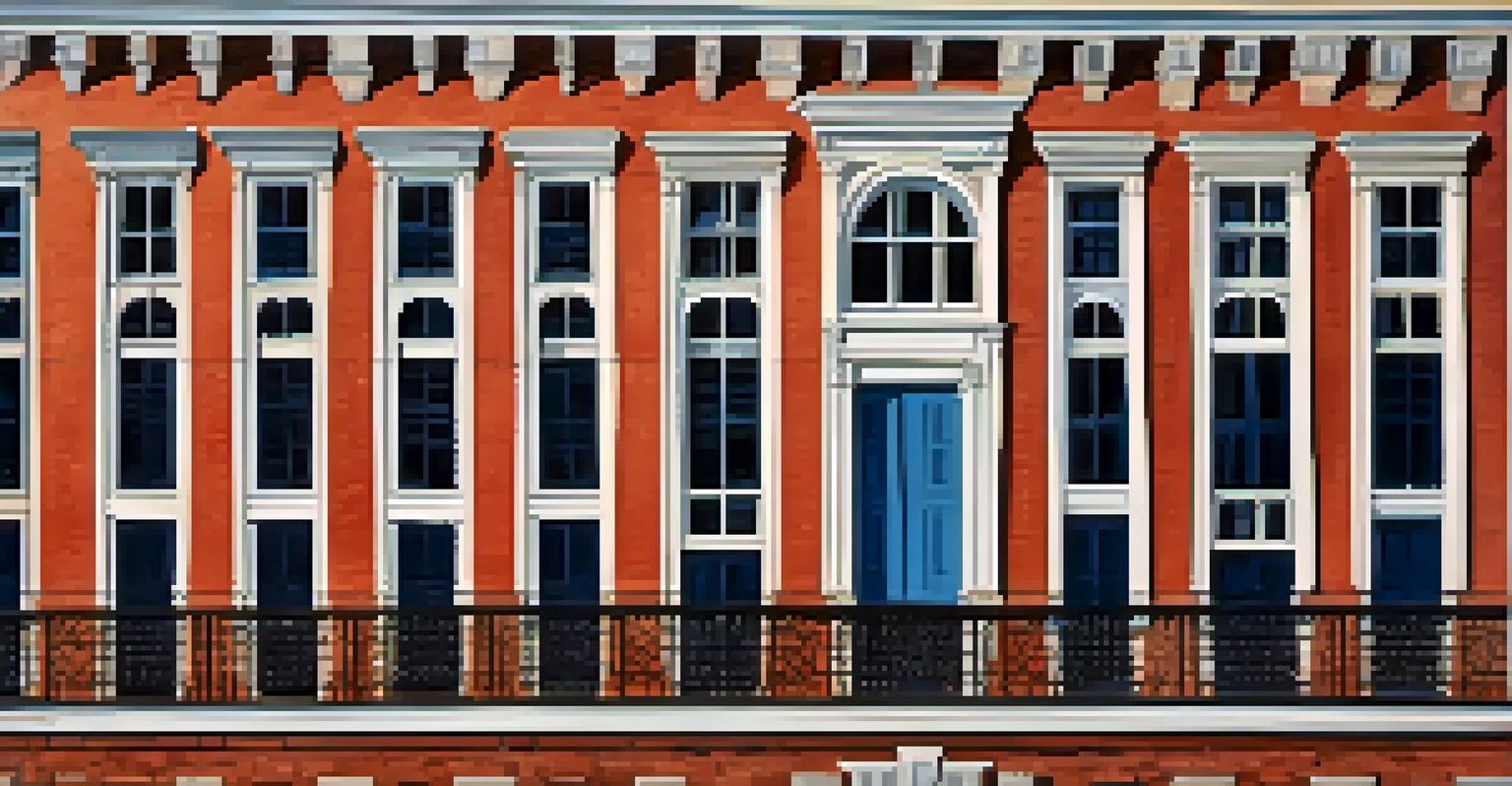The Influence of Colonial Architecture on Savannah's Design

Understanding Colonial Architecture in Savannah's Context
Colonial architecture in Savannah reflects the rich history of the city, established in 1733. This style, primarily influenced by British and Spanish designs, showcases the cultural blending that defines Savannah. The use of red brick, stucco, and intricate woodwork speaks to the craftsmanship of the era, offering a glimpse into the life of early settlers and their inspirations.
Architecture is the learned game, correct and magnificent, of forms assembled in the light.
When strolling through Savannah, one can easily spot the iconic features of colonial architecture. These include tall, narrow windows, spacious verandas, and symmetrical facades, all of which contribute to the city’s charm. This style not only serves an aesthetic purpose but also provides insights into the practical needs and lifestyles of its inhabitants throughout the centuries.
Moreover, the preservation of these buildings plays a crucial role in maintaining Savannah's identity. Efforts to restore and protect these historical sites ensure that future generations can appreciate the architectural legacy left behind by colonists, fostering a deeper understanding of the city’s past.
Key Features of Colonial Architecture in Savannah
Savannah's colonial architecture is marked by several distinctive features that set it apart from other American cities. One prominent element is the use of brick and tabby, a concrete-like material made from oyster shells, which was abundant in the region. This not only provided durability but also reflected the local resources available to builders during that time.

Another characteristic is the emphasis on symmetry and proportion, which can be seen in the design of homes and public buildings. The strategic placement of doors, windows, and porches creates a balanced aesthetic that is both pleasing to the eye and functional for the Southern climate. This attention to detail highlights the thoughtfulness behind each structure.
Colonial Architecture's Lasting Impact
Savannah's colonial architecture showcases a blend of British and Spanish influences, reflecting the city's rich cultural history.
Lastly, the incorporation of gardens and outdoor spaces is a vital aspect of colonial design. These areas were not just for beauty; they were essential for social gatherings and community engagement. The lush greenery surrounding these buildings enhances their appeal and offers a glimpse into the lifestyle of Savannah's early residents.
The Role of Geography in Shaping Savannah's Design
Savannah's unique geography has had a profound influence on its architectural style. Located near the Savannah River, the city's layout was designed to accommodate both trade and defense. This strategic positioning required buildings to be both functional and aesthetically pleasing, leading to the development of iconic structures that harmonize with the natural landscape.
A building is not just a place to be, but a way to be.
The coastal climate also played a significant role in architectural choices. High ceilings, large windows, and spacious porches were essential for ventilation and cooling, making homes more comfortable during hot summers. These elements not only reflect practicality but also embody the Southern hospitality that Savannah is known for.
Additionally, the city's grid system, designed by General James Oglethorpe, incorporates public squares that serve as focal points for community gatherings. This thoughtful planning highlights how geography and design are intertwined, contributing to Savannah's charm as a walkable city filled with history and beauty.
Colonial Influences on Modern Savannah Architecture
While Savannah's colonial architecture is rooted in the past, its influence is evident in contemporary designs throughout the city. Modern architects often draw inspiration from traditional elements, blending them with modern materials and techniques to create unique structures. This fusion maintains the historical essence while embracing innovation.
For instance, many new buildings incorporate large porches and open floor plans reminiscent of colonial homes, catering to today's lifestyle. This design choice reflects the ongoing appreciation for outdoor living spaces and community interaction, echoing the social principles of the colonial era.
Preservation Efforts Matter
Active preservation initiatives are vital to maintain Savannah's historical integrity, fostering community pride and attracting tourism.
Moreover, the preservation of colonial structures encourages a dialogue between past and present. As new developments emerge, they often seek to complement or enhance their historical surroundings, ensuring that Savannah's architectural narrative continues to evolve while honoring its roots.
The Importance of Preservation Efforts in Savannah
Preservation efforts in Savannah are crucial for maintaining the city's historical integrity and architectural beauty. Organizations dedicated to this cause work tirelessly to restore and protect colonial structures from decay and modernization. These efforts not only safeguard the physical buildings but also the stories and heritage they represent.
Community involvement plays a significant role in these preservation initiatives. Local residents and volunteers contribute their time and resources, fostering a sense of pride and ownership in their city’s history. Events, educational programs, and tours help raise awareness about the importance of preserving Savannah's architectural legacy.
In addition, successful preservation efforts attract tourism, which is vital for Savannah's economy. Visitors come to experience the city's rich history and stunning architecture, providing a tangible connection to the past. This ongoing interest ensures that the stories of Savannah’s colonial architecture will continue to be told for generations to come.
Savannah's Colonial Architecture as Cultural Heritage
Savannah's colonial architecture is more than just a visual delight; it embodies the city's cultural heritage. Each building tells a story, reflecting the diverse influences that shaped the community over time. This rich tapestry of history offers residents and visitors alike an opportunity to connect with the past in a meaningful way.
The architectural styles found throughout Savannah also celebrate the melting pot of cultures that contributed to its development. From the British settlers to the Spanish and French influences, each group left its mark on the city's design. This cultural amalgamation is a testament to the resilience and adaptability of Savannah's people throughout history.
Exploring Savannah's Architectural Heritage
Visiting Savannah provides a unique opportunity to experience colonial architecture firsthand, offering insights into the city’s past.
As a living museum, Savannah's colonial architecture invites exploration and appreciation. Walking through the streets, one can experience the blend of history and modern life, making it a unique destination for those seeking to understand the complexities of American heritage.
Visiting Savannah: Experiencing Colonial Architecture Firsthand
For anyone intrigued by colonial architecture, visiting Savannah is like stepping back in time. The city offers countless opportunities to explore its historical sites, with guided tours that delve into the stories behind each building. These experiences allow visitors to appreciate the craftsmanship and design choices that define the city's character.
Walking tours provide a personal touch, allowing guests to engage with knowledgeable guides who share fascinating anecdotes about the city's past. From the grandeur of the Owens-Thomas House to the charm of the Juliette Gordon Low Birthplace, each stop offers a glimpse into Savannah's architectural journey.

Additionally, various events and festivals celebrate the city’s history, making it easy for visitors to immerse themselves in Savannah's unique culture. By experiencing the colonial architecture firsthand, one can truly understand its influence on the city and appreciate the legacy it continues to inspire.